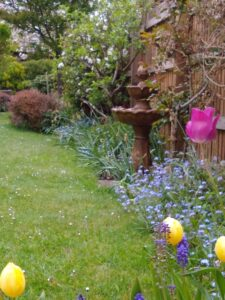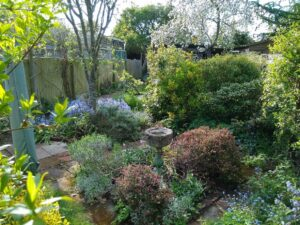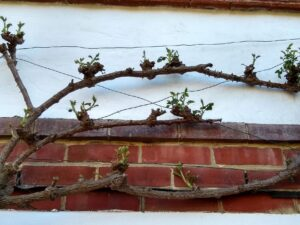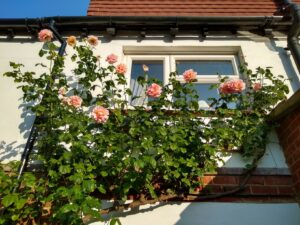Romantic and Japanese
May 14, 2021 Blog

When planning a garden over twenty years ago I was inspired, in part, by two concepts: the romantic garden and the Japanese garden.
I'd found a book called The Romantic Garden in the public library in Canterbury and it conveyed the idea of a garden being a place of mystery and discovery and hidden delights. It recommended, in particular, the creation of archways and of secret, hidden corners that one could meander around. The archways could be constructed, such as the wooden one I made half way down the path, over which there climbs both a purple rambling rose and a white summer jasmine. It can also be made from the branches of a tree or shrub, and I've created over the years some nice such overhangs. When choosing a small tree for the front garden one of the principal considerations was selecting one that had a branch that could be trained to arch over the pathway. It's taken a long time but it's getting there!
I've loved as well the creation of different and distinct little areas. In the summer, when leaves have grown back, you can walk round a gathering of shrubs and find yourself in one area, or take an alternative route and be somewhere else with some other colours or smells or shapes to enjoy! How blessed I have been during the lockdown to be able to wander out several times a day under the archways or along the meandering paths. Or just to sit on one of the strategically placed benches and to listen to the birds.
I find that plants are quite similar to people, in some respects. Plants can be very temperamental, and fussy about where they are and who they are with! I've had to move some shrubs up to three times until they finally found the spot they were happy with. Some shrubs, like clematises and roses, don't like anything else to be too close to them. They want to be the star of the show and if allowed that honour then they flower in abundance. There are lots of other considerations. Sun or shade, how much water, the kind of soil that different shrubs like, when and how much to cut back. Just as with people, if we're in the right place then boy how we grow. It we're not then we can either stubbornly refuse to do anything or shrivel up altogether!
The idea behind the Japanese garden is that once the hard work of establishing it has been achieved, it should be fairly low maintenance. Rather than a place of constant toil it should be an oasis of calm, of peace and rest and order and tranquillity; a place of beauty and of respite for the soul. There will usually be flowing water in a Japanese garden but this feature was lacking in our own garden. Until this year! I had earmarked a spot for some kind of water feature and we chose in the end a solar-powered fountain. To sit out and listen to the gentle sound of trickling water is pure joy. Yim Soon laughs at me having to move the solar panel during the day to follow the sun (if indeed there is any sun) but it's totally worth it.
As much as I appreciate the low-maintenance aspect, I also relish the opportunity a garden gives for some good honest hard graft. This Spring I've been severely cutting back some shrubs that have grown too big. We all need a good prune from time to time! As the years have gone by I've become bolder in my pruning of the rose bushes, in particular, and am now pretty brutal with them when cutting back in the winter. They seem to like it, and we're richly rewarded come the summer with both colour and fragrance! In the Grande Chartreuse in the South of France there are, within the tall monastery walls, two rows of houses where each of the Carthusian monks lives a semi-hermit existence. Every house has its own garden and part of the monk's day is given to tending it. It is, in part, a recognition that working with the earth is incredibly good for body and mind. I know how satisfied and centred I feel after a good session of digging or cutting or planting.
Planting a garden needs a lot of hard work and vision and faith. It also requires patience, not perhaps a popular virtue in a world where things are expected to happen instantly. As I once again enjoy the wonderful sight of wisterias coming into bloom I'm reminded that some species can take twenty years until they produce their first flower. The person who first planted that little wisteria shrub might not be around to see any of its lovely purple flowers, let alone the spectacular sight of it draped all over a five-storey townhouse. I planted a new camelia over a year ago. I know that they like clay soil which we have in our garden and I thought I'd found a good spot but it hasn't this year produced any flowers! I've been inspecting it every day. I hope that it's not like the German proverb that a watched pot never boils i.e. a watched camelia never blooms! Maybe it just needs time to put down solid roots? I'll give it a bit of a prune in a month or so and I'll also try to ignore it for a while! If it doesn't produce the goods next year I can always move it!
There are many proverbs from around the world about gardens and I rather like this Portuguese one: 'More grows in a garden than the gardener sows there.'
I'm thankful for my place of rest and rejuvenation, according to the Japanese garden ideal. And regarding the concept of the romantic garden, I'm grateful too for that daily sense of mystery and discovery. There is indeed in a garden more, far more, that the gardener sowed.







